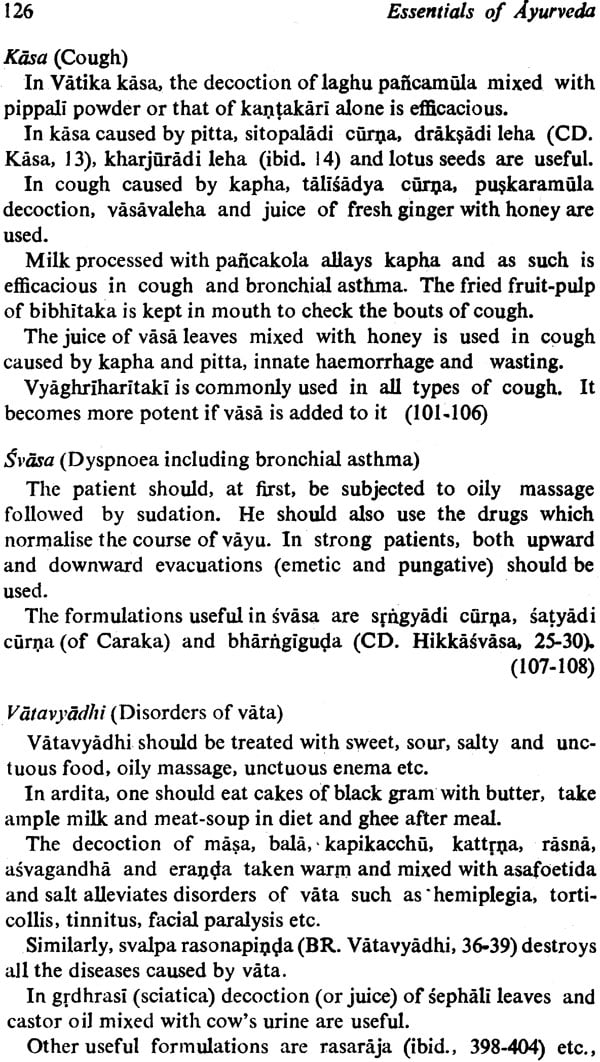
Essentials Of Ayurveda
Book Specification
| Item Code: | IDE049 |
| Author: | Priya Vrat Sharma |
| Publisher: | Motilal Banarsidass Publishers Pvt. Ltd. |
| Language: | Text and Translation of Sodasangahrdayam |
| Edition: | 2009 |
| ISBN: | 9788120815179 |
| Pages: | 358 |
| Cover: | Paperback |
| Other Details | 8.5" X 5.5" |
| Weight | 460 gm |
Book Description
There is a growing consciousness all over the world to know about Ayurveda, the earliest medical system of India, which has survived the vicissitudes of time for centuries and is still living and acting with vigour. Initially Ayurveda was one whole but later on was divided into eight specialities (angas) and still further, in present times, into sixteen ones.
Till date there is no book dealing with all these specialities at one place presenting an integrated picture of Ayurveda. The present publication, 'Essentials of Ayurveda', is significant in the sense that it contains the essence of all the sixteen specialities of Ayurveda by which one could get working knowledge of Ayurveda as a whole. The book, in a sense, is the first representative work of the present age composed in traditional scholarly style. The English translation by the author himself has enhanced its value for the readers. The present work will prove useful not only for teachers and students but also for all those who want to be acquainted with principles and practice of Ayurveda easily.
Prof. P.V. Sharma is well known for his valuable contributions in the field of Ayurveda. For the last five decades he has been writing on various aspects of Ayurveda - literary as well as scientific, conceptual as well as historical.
Born on 1st November 1920 in a small village Mustafapur near Patna in the highest degrees in Ayurveda and Sanskrit from Banaras Hindu University and held highest academic and administrative positions in B.H.U. and Bihar Govt. He retired in 1980 after having served his alma master as Professor and Head, Deptt. Of Dravyaguna; Director, Postgraduate Institute of Indian Medicine and Dean, Faculty of Indian Medicine.
Prof. Sharma has been participating in International conferences abroad and has been associated with several committees on Ayurveda on National level. He has authored about 50 books and has about 500 published papers to his credit.
Ayurveda or the Veda of ayus (Science of life) is the medicine of India coming down traditionally from the earliest times. Caraka says that it was revealed by Brahma, the Creator, Himself while Susruta goes one step further by stating that it was delivered even before creation. Generally Ayurveda is recognised as an upaveda related to either Rgveda or Atharvaveda. Kasyapa takes it as the fifth veda and gives it the topmost position among them. All this proves its existence since antiquity as Caraka explicitly says it sasvata (eternal) with untraceable beginning.
Even in pre-historic India, evidences of medicine are found. In Harappa and Mohenjo-daro, seals with images of Lord Basupati (Siva) have been found, who is regarded as the first divine physician. Besides there are also found, remains of substances of vegetable, animal and mineral origin used as-drugs. In Vedas too, immense material is found relating to medicine. The osadhi-stikta of the Rgveda (10.47.1-23) is an important document on ancient Botany and vegetable drugs., The miracles of Asvins show an advanced state of medicine and surgery. It is further developed by the traditional healers as seen in the Atharvaveda.
The medical knowledge acquired in the early age was documented systematically and organised scientifically in the compendia (samhitas) of Ayurveda of which the Caraka-samhita, the enlarged and redacted edition of the Agnivesa-tantra, tops the list. During this period, the basic concepts were established and the whole system of medicine including physiology, pathology and pharmacology was rationalised. It, in fact, revolutionized the medicine of India by replacing the magical charms by rational therapeutic measures.
All this was made possible by the rich philosophical background and the atmosphere of free thinking characteristic of the upanisadic age.
Carakas, the wandering mendicants expert in medicine, contributed a lot to the evolution of Ayurvedic theories and practices? The greatest fundamental discovery of this age was the Law of the Uniformity of Nature (Loka—purusa - samanya) (Puruso’yam lokasammitah-CS. Sa. 5.3) which paved the way for observing the intimate relation between microcosm and macrocosm and for applying the physical laws governing gravitation, hydraulics, themodynamics, electricity, magnetism, motion etc. to the biological field. Moreover, minute observation of Nature and its phenomena led to postulation of many concepts.
| Chapter I | Basic Concepts | 3-12 |
| Chapter II | Sarira (Anatomy and Physiology) | 14-16 |
| Chapter III | Dravyaguna (Pharmacology) | 17-33 |
| Chapter IV | Bhesajakalpana (Pharmacy) | 34-61 |
| Chapter V | Rasasastra (Science of Mercury and Minerals) | 62-92 |
| Chapter VI | Svasthavrtta (Preventive and Social Medicine) | 93-99 |
| Chapter VII | Rasayana (Promotive Therapy) | 100 |
| Chapter VIII | Vajikarana (Aphrodisiac Therapy) | 101 |
| Chapter IX | Rogavijnana (Pathology and Diagnosis of Diseases) | 102-117 |
| Chapter X | Kayacikitsa (General Medicine) | 119-129 |
| Chapter XI | Manasa Roga (Psychiatry) | 130-134 |
| Chapter XIII | Kaumarabhrtya (Pediatrics) | 135-136 |
| Chapter XIV | Agadatantra (Toxicology) | 137 |
| Chapter XV | Salyatantra (surgery) | 138-139 |
| Chapter XVI | Salakya (Speciality Dealing with Supra-claviculr Diseases) | 140-141 |
| Appendix | 143 | |
| Bibliography | 167 | |







